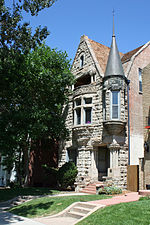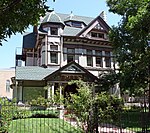Cathedral of St. John in the Wilderness
20th-century Episcopal church buildingsChurches completed in 1911Churches in DenverChurches on the National Register of Historic Places in ColoradoEpiscopal cathedrals in the United States ... and 3 more
Episcopal church buildings in ColoradoGothic Revival church buildings in ColoradoNational Register of Historic Places in Denver

Saint John's Cathedral in Denver, Colorado, United States is the seat of the bishop and the cathedral of the Episcopal Diocese of Colorado and part of the Episcopal Church in the United States. Construction began in 1909, the first service held in the cathedral in 1911, and it was added to the National Register of Historic Places in 1975. In 2020, it reported 1,949 members, 474 average attendance, and $1,498,586 in plate and pledge financial assistance.
Excerpt from the Wikipedia article Cathedral of St. John in the Wilderness (License: CC BY-SA 3.0, Authors, Images).Cathedral of St. John in the Wilderness
Washington Street, Denver
Geographical coordinates (GPS) Address External links Nearby Places Show on map
Geographical coordinates (GPS)
| Latitude | Longitude |
|---|---|
| N 39.738285 ° | E -104.97815 ° |
Address
Cathedral of St. John in the Wilderness
Washington Street 1350
80203 Denver
Colorado, United States
Open on Google Maps









